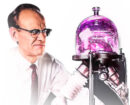And I dare say it’s been a long time coming…

News surfaced this past week that one of the world’s most prominent startup incubators, Y Combinator has taken a stake in a company called Helion, which insists that it will produce a break-even nuclear fusion process in three years:
So it came as a surprise to hear that Y Combinator and Mithril Capital Management are investing $1.5 million in Helion Energy, a Redmond, Washingon-based startup that says it has a plan to build a fusion reactor that breaks even on energy input and output, a challenge whose solution has been considered decades away for, well, decades. Helion CEO David Kirtley says that his company can do it in three years….
…When the team left to form their own company, they did so with the express intention of using electronics advancements from other fields to create a magnetic-inertial confinement fusion reactor.
I suppose it’s good news that this initiative will be using “electronics advancements” in the development of their fusion process. Lord only knows that the advancements in electronic monitoring and computer control are light years ahead of what a fusion pioneer like Philo Farnsworth had at his disposal in the 1950s and 60s.
But as soon as I read that the process revolves around “magnetic” confinement (even if it is some kind of hybrid with inertial confinement) I become pretty skeptical. I forget who it was but long ago somebody likened magnetic plasma confinement to trying to wrap jello in rubber bands. That much has not changed, and billions – maybe hundreds of billions – have been spent over the past several decades on monolithic systems that pretty well prove the point.
Nevertheless, it is encouraging that the Silicon Valley tech/startup community is taking at least a marginal interest in the promise of fusion. And these guys do have the right idea to decentralized, distributed power network:
Instead of building at the scale of a gigawatt power station right out of the gate, the company is looking to compete with smaller, more distributed plants, like large diesel generators in regions where fuel has to be trucked in. It’s a market where the current “best” solution isn’t great and the barriers to entry are far easier to deal with than when competing with the big guys.
But they still have to find a fusion process that actually produces more power than it consumes.
Lord knows, if this server-farm reality we’ve created for ourselves is going to be sustainable, we’re going to have to find some source of electricity other than fossil fuels – and fusion, if it can ever be achieved, offers at least the siren song of temptation for the biggest bang for the buck.
So it’s good to see the Big Bucks that technology has generated finally taking a serious interest in the field. It’s about time the prospect of fusion energy appealed to some deep pockets other than government funding.
